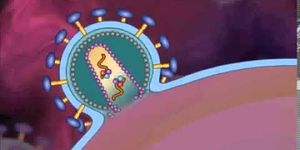Videos
HIV AIDS Replication Animation Video
MAY 15, 2014 12:00 AM PDT
Share
Science as Art
 According to Brandon Ballengée's website, he is a visual artist, biologist and environmental activist. His art has been exhibited in museums and galleries all over the world, and he has a Ph.D. in biology and art.
According to Brandon Ballengée's website, he is a visual artist, biologist and environmental activist. His art has been exhibited in museums and galleries all over the world, and he has a Ph.D. in biology and art.Ballengée creates what he refers to as "transdisciplinary artworks." Since the mid-1990s, the focus of his work has been on developmental deformities and population declines among amphibians. In 2009, Ballengée co-authored a paper with Stanley K. Sessions titled "Explanation for Missing Limbs in Deformed Amphibians" in the Journal of Experimental Zoology.1
Ballengée is inspired by his ecological field and laboratory research, in particular, his experience witnessing the struggle of deformed animals to survive on land. His art is a way for him to memorialize the animals he finds and provide a window into ecosystem health. In the statement of intent published on his website, Ballengée explains: "Since 1996, my transdisciplinary practice has bridged primary scientific studies with ecological art and engaged environmental stewardship. Underlying my practice is a systemic methodology, which posits art practice as a means of realizing research science, and vice-versa. Inherent to this working method is an impetus for "ecosystem activism" implemented through participatory biology field investigations and laboratory programs that stress public involvement - my attempt at social sculpting."
In an April 2014 interview for National Public Radio (NPR) Ballengée put it this way: "You have this animal that's just struggled its very short life, trying to make it to land, and suddenly they get to land, and they don't have the tools to survive. They're just laying there dying."
Science and art have much in common. Both require attention to detail, intuition, an appreciation for the natural world, curiosity, and an interest in sharing the direct experience of discovery.
In Ballengée's case, science and art also share a disciplined approach to technique. As explained in his NPR interview, Ballengée creates his portraits using a technique called "clearing and staining." From a scientific viewpoint, this technique helps to reveal how deformities may have developed. Artistically, the staining process transforms the frogs to, as Ballengée puts it, "...resemble gems, or the stained glass windows found in some cathedrals." To create the images, Ballengée first scans the cleared and stained frogs at high resolution then overlays them with individual photos in Photoshop, creating a crystal clear, 3D appearance.
Ballengée names his images after those of Greco-Roman mythology. The image pictured above is named after Phaethon, son of Clymene and Helios, who after being allowed to sun chariot for a day, lost control of the horses and was destroyed by a thunderbolt from Zeus to prevent disaster.
"Heroic and terrible things happen to [those] characters," Ballengée says. "I wanted to somehow recall that."
Reference: Brandon Ballengée, Stanley K. Sessions. (2009) Explanation for missing limbs in deformed amphibians. Journal of Experimental Zoology Part B: Molecular and Developmental Evolution 312B:7, 770-779
Image: DFA 147 Phaethon, Brandon Ballengée, 2013. Iris print on Arches watercolor paper. Cleared and stained Pacific tree frog collected in Aptos, California in scientific collaboration with Stanley K. Sessions.
You May Also Like
Loading Comments...








